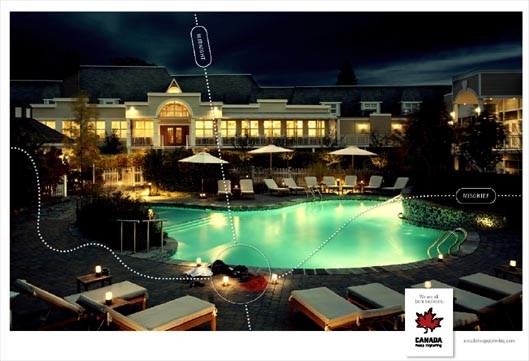Clothing abandoned by a hotel pool, scattered swim gear by an empty lakeside dock, an astronaut exploring the moon’s surface, and a diver checking out a manta ray.
These are some of the images the Canadian Tourism Commission (CTC) hopes will lure more tourists to Canada.
In an effort to boost numbers from abroad to Canada by one-quarter over the next five years, the commission is launching an $11 million advertising campaign.
"We’re not trying to make Canada sexier, but perhaps more provocative," said CTC’s top marketing executive.
The "Canada — keep exploring" campaign set to launch next month in Britain, France and Germany focuses on personalizing the Canadian experience for travelers, Greg Klassen, vice-president of marketing, said, from his new Vancouver office. (The commission relocated to Vancouver from Ottawa this week, the first federal agency to ever do so.)
"We’re aiming for the curious traveler, letting them know Canada is not only a place of natural beauty but also progressive, diverse, and exciting."
In addition to traditional magazine and newspaper ads, the commission will use "guerilla" marketing tactics like dispatching Smart Cars with full-vehicle length advertising through Paris to attract attention. "It’s a clever and unusual way to get the message, ‘we are all born explorers,’ across," Klassen said. "It’s using the choice of media as the message."
The new brand was prompted by recent World Tourism Organization rankings that placed Canada as 12 th in terms of total tourism arrivals. Statistics Canada also reported last month that Americans are visiting less, down almost six per cent in the most recent quarter. But Europeans, in particular British, are coming to Canada in greater numbers. Statistics Canada reports an 8.1 per cent increase from April to June of this year over the previous year’s same quarter.
DDB Canada is the advertising firm hired to keep those numbers coming. William Hammond is the creative director whose team thought of using Smart Cars, the Internet and even coffee cups in European java houses to energize CTC’s marketing strategy. Creating an emotional bond between the traveler and how they experience Canada is part of the campaign.
"People who come to Canada say it’s not just the experience of looking at the mountains that they remember, but the people they met while looking at the mountains," Hammond said.
Canada is a very abstract concept that can’t equate just one image with one emotion, as can France’s Eiffel tower with romance, Hammond said. The challenge for his team, who have managed CTC’s marketing since 2002, was to create a campaign that highlighted the multiple layers of experiences Canada has to offer.
"It’s not just one thing, it’s everything," he said from his Toronto office.
European coffee houses will feature cups printed with "This end to wall, this end to ear" and "In case of adventure use these crumbs to find your way home" on bakery bags with a maple leaf. The slogan and website canadakeepexploring.com will also be included.
Hammond says although the campaign begins next month with the European market the concepts have to be flexible enough to migrate to Latin American, Asian and Canadian campaigns.
CTC’s Klassen says the target audience is typically 35-55-year-old women, who turn to the Internet for gathering information and booking trips to Canada.
"Women make most travel decisions, whether as part of a couple or part of a family," he said.
Tourism Whistler’s president says the Canadian Tourism Commission’s campaign should fit well with Whistler’s Always Real marketing strategy.
"What they’re doing makes sense," Barrett Fisher said. "What they’re trying to get across is that we’re not boring. There is excitement to be had, whether it’s a little village in Quebec or a resort in B.C. There are more depths of personality to us."
Fisher echoed Hammond’s contention that although Canada is recognized by traditional icons of wide open spaces and RCMP red serge, there is also a cultural diversity and range of experiences that haven’t always been thoroughly explored.
Hammond says that Canadian marketing in the past has been "too la-de-da, the language has been too flowery. When you walk down a (Canadian) street it doesn’t feel like that. It’s important that Canadians see these spots and say ‘yea, that’s true of us.’ Canada is a young, multi-cultural country," he said. "We are not necessarily cheeky, we are polite, but we need to be politely proud of what we have to offer."




